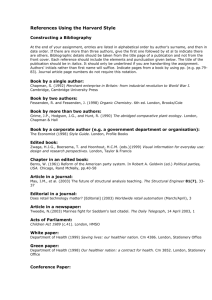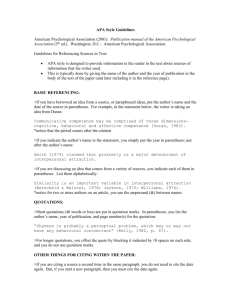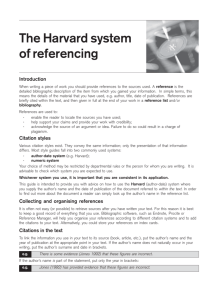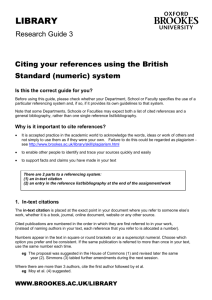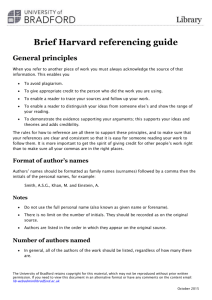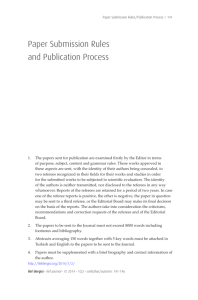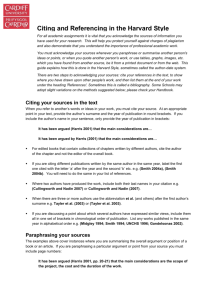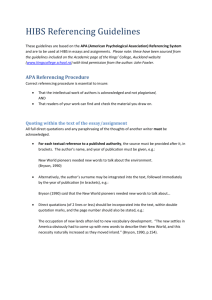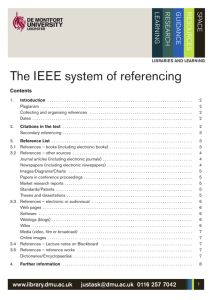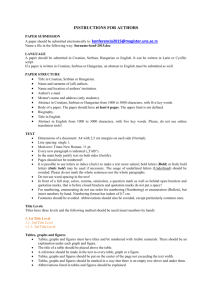Harvard Referencing Guide: Citations & Reference Lists
advertisement
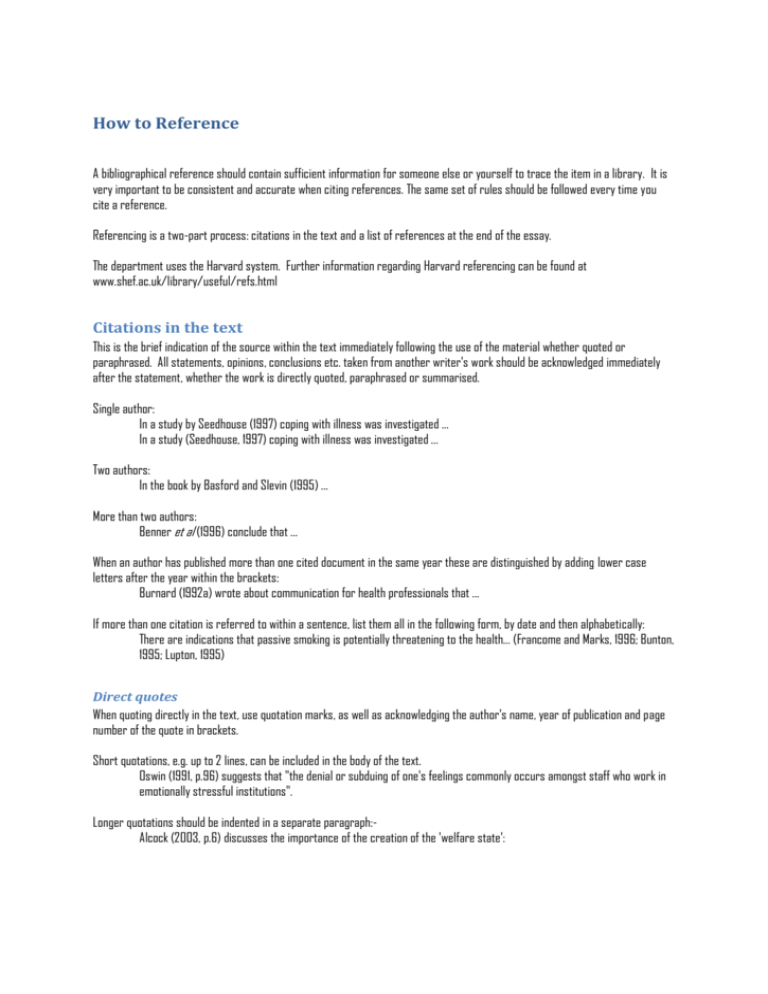
How to Reference A bibliographical reference should contain sufficient information for someone else or yourself to trace the item in a library. It is very important to be consistent and accurate when citing references. The same set of rules should be followed every time you cite a reference. Referencing is a two-part process: citations in the text and a list of references at the end of the essay. The department uses the Harvard system. Further information regarding Harvard referencing can be found at www.shef.ac.uk/library/useful/refs.html Citations in the text This is the brief indication of the source within the text immediately following the use of the material whether quoted or paraphrased. All statements, opinions, conclusions etc. taken from another writer's work should be acknowledged immediately after the statement, whether the work is directly quoted, paraphrased or summarised. Single author: In a study by Seedhouse (1997) coping with illness was investigated ... In a study (Seedhouse, 1997) coping with illness was investigated ... Two authors: In the book by Basford and Slevin (1995) ... More than two authors: Benner et al (1996) conclude that ... When an author has published more than one cited document in the same year these are distinguished by adding lower case letters after the year within the brackets: Burnard (1992a) wrote about communication for health professionals that ... If more than one citation is referred to within a sentence, list them all in the following form, by date and then alphabetically: There are indications that passive smoking is potentially threatening to the health... (Francome and Marks, 1996; Bunton, 1995; Lupton, 1995) Direct quotes When quoting directly in the text, use quotation marks, as well as acknowledging the author's name, year of publication and page number of the quote in brackets. Short quotations, e.g. up to 2 lines, can be included in the body of the text. Oswin (1991, p.96) suggests that "the denial or subduing of one's feelings commonly occurs amongst staff who work in emotionally stressful institutions". Longer quotations should be indented in a separate paragraph:Alcock (2003, p.6) discusses the importance of the creation of the 'welfare state': "the most important development in social policy, and the most important feature of it for academic study, was the creation of what has come to be called the welfare state in the years immediately following the Second World War" (but indented quotes do not need quotation marks) If part of the quotation is omitted then this can be indicated using three dots:Weir and Kendrick (1995, p.88) state that "networking is no longer solely within the male domain …” Direct quotations can be contrasted with paraphrasing, for example: There have been many important developments in social policy since 1945, but none can be considered more important than that which allowed the development of the so-called 'welfare state' (Alcock 2003, p6). This development... Secondary referencing Secondary referencing is when one author is referring to the work of another and the primary source is not available. You should cite the primary source and the source you have read, e.g. (Fiedler and Chemers, 1974, cited in Douglass, 1996). Secondary referencing should be avoided if at all possible. List of references This is a complete list of all the cited references used in the assignment or paper with full bibliographic details. The reference list must list all and only those works cited in the text, conversely, the text should include all references listed in the reference list (also called the bibliography). All of the references must be listed in alphabetical order by author's surname and then by date (most recent first). References should be separated by a blank line, for clarity of reading. Whenever possible, details should be taken from the title page of a publication, and not from the front cover, which may be different. Each reference should include the elements and punctuation given in the examples below. Book references Book references should be in the form: Author name, Initial. (Date) Title of publication, Edition or Series statement, if required, Place of publication, Publisher. A book by a single author: Kivisto, P. (1998) Key Ideas in Sociology, London, Pine Forge Press. A work by two authors: Ritzer, G. and Goodman, D. (2003) Sociological Theory, London, McGraw-Hill. A work by three or more authors: Bochel, C., Page, R., Sykes, R. and Bochel, M. (2004) Social Policy: Issues and Developments, London, Prentice Hall. Whilst et al is used after the first authors name within the parenthetical reference in the text (Bochel et al, 2004), all authors must be listed in the list of references. A book by a corporate author (e.g. a government department or other organisation): Department of Health (2000) Assessing Children in Need and their Families: Practice Guidance , London, The Stationery Office. An edited work: Taylor, S. (Ed) (2000) Sociology: Issues and Debates, Basingstoke, Palgrave. Chapter references References to a chapter in a book should be in the form: Author name, Initial. (Date of publication) Title of chapter, in Editor's Surname, Initial. (Ed) Title of the Book, Place of publication, Publisher, page numbers. For example: Whittaker, J. and Kenworthy, J. (2002) Education services: why segregated special schools must close, in Race, D. (Ed) Learning Disability - A Social Approach, London, Routledge, pp68-84. Article references Journal article references should be in the form: Author's name, Initial. (Date of publication) 'Title of the Article', Title of the Journal, Volume (Part), Page numbers. For example: Arkani, S. and Gough, O. (2007) 'The Impact of Occupational Pensions on Retirement Age', Journal of Social Policy, 36 (2), pp297-318. An article in a newspaper: Nutt, K. (2006) 'Labour Social Policy 'Must Pay Its Way'', Sunday Times, Sunday April 9 2006, pp9-10. Electronic sources of information Electronic references should be in the form: Author/editor surname, Initial. (Year) Title, Place of publication, Publisher. Available from: URL (accessed Day/Month/Year). For example: University of Sheffield (2007) Sociology, Anthropology, Social Policy and Social Work in the Library and on the Internet , Sheffield, University of Sheffield. Available from: http://www.shef.ac.uk/library/subjects/subsw.html (accessed 20/03/07). Electronic journal references should be in the form: Author's name, Initial. (Date of Publication) 'Title of the Article', Title of the Journal, Volume (Part), page numbers. Available from: URL (accessed Day/Month/Year). For example: Simpson, B. (2006) 'Scrambling Parenthood: English Kinship and the Prohibited Degrees of Affinity', Anthropology Today, 22 (3), pp3-5. Available from: http://www.blackwell-synergy.com/doi/pdf/10.1111/j.1467-8322.2006.00436.x (accessed 20/03/07). Example reference list Arkani, S. and Gough, O. (2007) 'The Impact of Occupational Pensions on Retirement Age', Journal of Social Policy, 36 (2), pp297318. Bochel, C., Page, R., Sykes, R. and Bochel, M. (2004) Social Policy: Issues and Developments, London, Prentice Hall. Bryman, A. (2001) Social Research Methods, Oxford, Oxford University Press. Department of Health (2000) Assessing Children in Need and their Families: Practice Guidance , London, The Stationery Office. Gallagher, C. (2003) 'Miscounting Race: Explaining Whites' Misperceptions of Racial Group Size', Sociological Perspectives, 46 (3), pp381-396. Available from: http://www.jstor.org/view/07311214/ap050083/05a00060/0 (accessed 20/03/07). Kivisto, P. (1998) Key Ideas in Sociology, London, Pine Forge Press. Nutt, K. (2006) 'Labour Social Policy 'Must Pay Its Way'', Sunday Times, Sunday April 9 2006, pp9-10. Ritzer, G. and Goodman, D. (2003) Sociological Theory, London, McGraw-Hill.
